The Sassanians (226-651 AD) designated themselves as “…the Aryan realm/nation” or “Eiran-Shahr” as seen in Pahlavi script in lines 1-6 at the SKZ (Shapur Kaba Zartusht). Shapur (lit. Son of the King) I (r. 241-272 AD) assumed the Sassanian throne from his father Ardashir Babakan (r. 224-241 AD), who founded the dynasty.
Shapur had been present in the battles of his father from the early days of the rebellion in Persis to the campaigns of Alexander Severus. Shapur had proven himself to be a capable warrior and his exploits soon exceeded those of his father. His first military action as king was to capture the city of Hatra, whose formidable defenses had withstood the armies of Rome and Ardashir alike. The strategic fortress city of Nisibis was also captured by 241 AD (or perhaps earlier in Ardahsir’s time in 238 AD. Shapur’s tactic was to rapidly approach the city with the Savaran and to surround it. The obstinate defenders of Nisibis proved difficult to defeat, however these were finally subdued when a breach was created in the city’s otherwise impregnable walls. The fall of Nisibis allowed Shapur to thrust into Syria, leading to the capture of Antioch and Carrhae (Harran) (Zarrin’kub, 2002, p.193).
Gordian III attempts to defeat Shapur I
The young Emperor Gordian III (r. 238-244 AD) moved quickly to restore the Roman position in the Near East and to destroy Shapur. After some initial successes, Gordian crossed the Euphrates for his showdown with Shapur. There are two historical versions as to what transpired next.
The first version as stated by numerous Greco-Roman sources such as Ammianus Ammianus Marcellinus (XXIII, 5, 17), Festus (Brevarium, 22, p.64, 2-7), Jordanes (Historia Romana, 282, p.36, 27-31) states that Gordian met Shapur in a final battle and defeated him but was then murdered by the Praetorian Prefect, Phillip the Arab after the engagement. This was the “official” version as generally taught in the west until recently when further archaeological research and translations into English revealed a different version of these events.
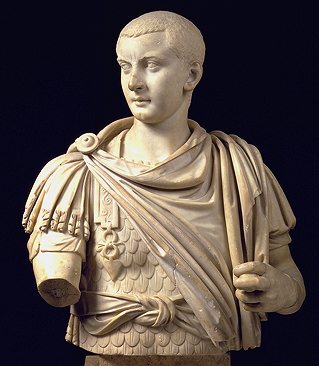
It is generally agreed that Gordian III, after some initial successes, lost his life in battles against Shapur I.
The Oracula Sibyllina (XIII, 13-20) and Zosimus (III, 32.4) clearly state that Gordian lost the final battle and his life fighting Shapur. The latter (largely ignored) version is corroborated archaeologically by the rock reliefs at Bishapur in Iran. These show Gordian being trampled under Shapur’s stallion. Interestingly Cedrenus notes that “He [Gordian] died after falling from his horse…” (I, p.450-451, I, 11-12). Orthographic verification of Shapur’s victory is provided by the inscriptions of Shapur (Dodgeon & Lieu, 1991, p.35) which clearly state that Gordian was decisively defeated at Misiche (modern Anbar) north of Ctesiphon in 244 AD. The Shapur inscription at Nagsh-e-Rustam states that “…at Mesiche, a great frontal battle occurred. Gordian Caesar was killed and the Roman force destroyed” (See translation of SKZ (Shapur Kaba Zartusht) in Appendix 4, 1984).
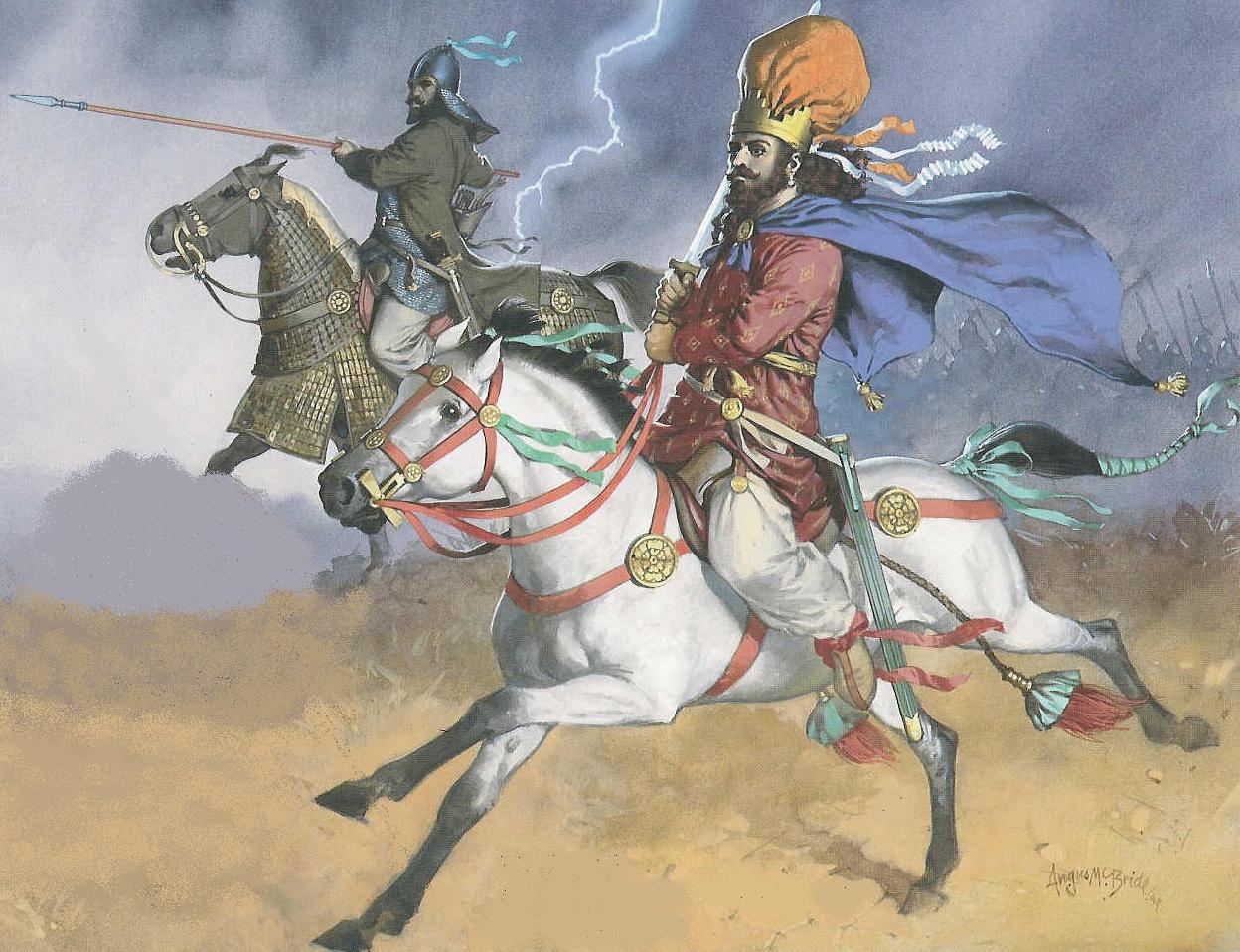
Shapur I as he may have appeared during his campaigns against the Roman armies in the 3rd century AD. By the 6trh centruy AD (or earlier) the broadsword had been relegated to ceremonial duties.
Phillip the Arab
After the defeat of Gordian at Mesiche, Phillip the Arab (r. 244-249 AD) became emperor of Rome. Phillip’s first act was to immediately made peace with Shapur. Roman sources corroborate Phillip as having made “a most dishonorable peace” (see Zosimus, III, 32. 4). According to the SKZ inscriptions, Phillip paid 500,000 Dinarii (Shapur Kaba Zartusht, see Appendix 4, Frye, 1984) as ransom to assure the safe return of the remnants of Godian II’s defeated Roman army at Mesiche. The Romans were also distraught that Phillip had conceded Armenia and Mesopotamia as belonging to Shapur (Zonaras XII, 19, p.583, 1-5). To add insult to injury, the Sassanians had re-named Mesiche as “Peroz-Shapur” (lit. victorious Shapur) (SKZ (Shapur Kaba Zartusht), see Greek lines 9-10).
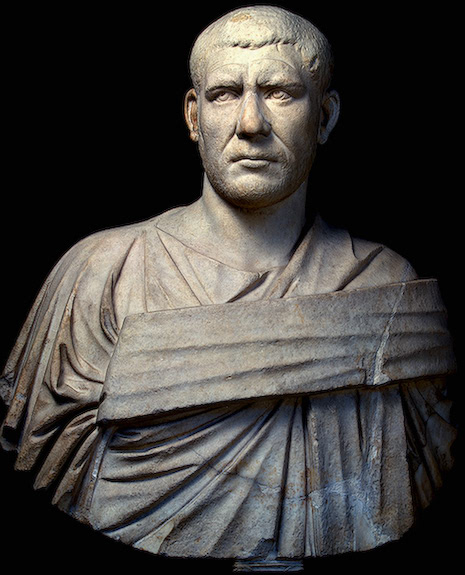
Roman Emperor, Phillip the Arab who after making “a dishonorable peace” with Shapur I, attempted to reverse this by attacking Sassanian Iran when the Savaran (Sassanian elite cavalry) were engaged in battles to the north and east. When Shapur I returned he completely defeated Phillip and the Roman forces.
The humiliating treaty proved too bitter for the Romans to swallow. Phillip reneged on the terms of his treaty with Shaour and duly marched back into Armenia and Mesopotamia. Phillip timed his attack just as Shapur was in the midst of concluding his campaigns in Northern and northeastern Persia to obtain the allegiance of the remaining Medes, Khwarazmians, Kushans, Giloi, and Dailamites. It was during these campaigns that the city of NevShapur (modern Nishabur) was founded in Khurasan, northeast Iran.
The timing of his Phillip’s attack evidently caught the Sassanians by surprise (Zonaras XII, 19, p.583, 5-9) in 253 AD. It did not take long for the Sassanians to strike back. Having successfully concluded his campaigns to the north and northeast, Shapur returned with his army to the west, and was now accompanied by the tough northern Iranian Dailamite infantry as well as cavalry (Giloi, Khwarazmians, etc.).
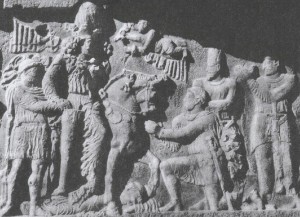
Rome meets its match: Bishapur depiction of Shapur I (mounted on horse) clasping Emperor Valerian (standing to the left) and Phillip the Arab pleading for mercy (on his knee). Below the hooves of Shapur I’s steed is barely visible the trampled body of Gordian III.
The Shapur inscriptions report that
“…Caesar [Phillip] lied again and did wrong to Armenia. We [Shapur and his army] marched against the Roman Empire and annihilated an army of 60,000 men at Barbalissos” (See translation of SKZ (Shapur Kaba Zartusht) in Appendix 4, 1984).
This now tore a wide gap in the Roman position in Mesopotamia leading to the fall of (once again) Antioch to “the arrow-shooting Persians” (Oracula Sibyllina XIII, 89-102) by c.256 AD. At this juncture Zosimus notes that
“…the Persians could have conquered the whole of Asia had they not been overjoyed at their excessive spoils…” (Zosimus, I, 27.2).
Most likely, Shapur’s strategy was to simply consolidate his empire’s position rather than attempt a vast territorial expansion at Roman expense.
The case of Dura Europos: “Gas warfare” or smoke inhalation in confined tunnels?
One of the areas to fall to Shapur during his campaigns along with Antioch was Dura Europos around 256 AD (exact dates are disputed). This was a site that changed hands between the Romans (later Romano-Byzantines) and the Partho-Sassanian empires of Iran several times. The site is of interest in that it shows a number of details pertaining to Parthian armored knights. There is also a depiction of a man in Iranian dress believed to be portrayal of Zoroaster.
The Sassanians were much better than their Parthian predecessors in siege works and soon proved to the equal of the Romans in siege-craft. The Sassanians used a wide variety of techniques in their siege warfare techniques, and even adopted certain techniques from the Romans. The array of Sassanian equipment included mangonels, siege towers, etc. Massed archery by infantry during sieges was a technique going back to the days of the Assyrians. One of the valuable finds at Dura Europos are the remains of the Sassanian soldier which provides valuable clues on Iranian helmets, mail and other infantry equipment at the time.
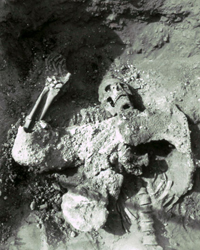
Remains of the Sassanian Soldier at Dura Europos (University of Leicester)
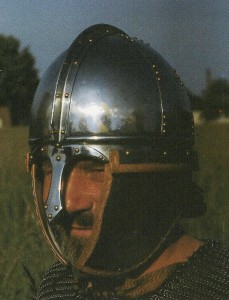
Reconstruction of a Roman helmet based on the sassanian designs (Peterson, 1992). After their defeats against Sassanian cavalry, the Romans adopted various facets of Sassanian technology.
One technique in which both the Romans and the Sassanian were highly proficient in was mining and counter-mining. Simply put, this would be the technique of trying to burrow into an enemy fortress by building mines. The besieged would then construct their own counter-mines to prevent enemy mines from encroaching into the fortress. Often, these mining and counter-mining operations entailed bitter hand to hand combat in narrow and confined spaces.
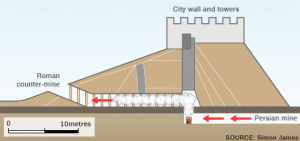
Sassanian mining and Roman anti-mining operations at Dura Europos as described by Simon James.
There is now new research regarding what may have occurred in one the Sassanian mines digging towards Dura Europos. Simon James of the University of Leicester, who is one of the world’s leading expert and archaeologist of Dura Europos has presented findings that one of the tools used by the Sassanians was the burning of bitumen and sulphur crystals, resulting in the asphyxiation of a number of Roman troops in one of the mines. Not surprisingly, reputable mainstream media sources reporting the James findings print dramatic headlines such as the BBC report’s “Ancient Persians gassed Romans”
Professor Simon James does state that:
Use of such smoke generators in siege-mines is actually mentioned in classical texts, and it is clear from the archaeological evidence at Dura that the Sasanian Persians were as knowledgeable in siege warfare as the Romans; they surely knew of this grim tactic.
To BBC’s credit, the above statement was cited from the original University of Leicester report. Nevertheless the title of the report may lead to the nuanced impression that the Sassanians primarily relied on “chemical weapons” or “gas warfare” in their battles and that the Romans did not. The simple fact is that both the Roman and Iranian empires were cognizant of a variety of techniques (as noted by Professor James) including bitumen and sulphur crystals. The Romano-Byzantines for example used a deadly form of rudimentary “napalm” known “Greek fire:” in naval warfare.
Bitumen and sulphur crystals are deadly only in narrow and confined spaces with little or no ventilation egress – the more appropriate phenomenon that occurs in this case is a form of smoke inhalation, but this is not neceassarily “gas warfare” where manufactured chemicals are deployed against the enemy in open spaces. Bitumen and sulphur crystals indeed give off noxious fumes and smoke as James avers, but these are not “chemical weapons” in the modern sense of (human manfactured) Sarin, Tabun, Mustard or nerve gases which are used in open spaces as used by Saddam Hussein in the 1980s against Iranian troops and Iraqi Kurdish civilians at Halabja in 1988.
The siege of Dura Europos is a field of study that will be examined for decades to come. Few serious scholars would suggest that the successes of Shapur I were due to “Chemical warfare“. Shapur’s victories against his Roman opponents were primarily due the Savaran, the elite Sassanian cavalry. It was these who were to inflict upon Rome one of her most dramatic defeats in history.
The Final showdown with Emperor Valerian
Valerian (r. 253-260 AD) ascended to the throne in 253 AD and soon organized a third Roman army to help restore Rome’s defeats against the Sassanians. The Romans wanted to destroy Shapur, the Sassanian army and the new Iranian empire.
Valerian soon cleared Antioch of Sassanian troops by c.256 AD, prompting Valerian to strike his own “victory” coins. This celebration proved premature as Valerian had thus far only confronted second-rate garisson troops. He had yet to face Shapur’s first-rate Savaran cavalry. Shapur, had in fact conserved his cavalry and main army. He then deployed to Carrhae (Harran) and Edessa. Valerian rashly deployed his mainly infantry army towards Edessa-Harran, a flat region ideal for cavalry operations. This was the same region where Crassus’ troops had been crusehd by the Parthian cavalry over 200 years before.
History was to indeed repeat itself: the Savaran decisively crushed the Romans (Festus, Brevarium, 23, p.64, 8-13) and captured 70,000 troops, including senators and the Roman Praefect in c.260 AD. The Shapur inscriptions also report a large range of European prisoners, including
“Germany…Dacia [Modern Romania], Pannonia [Modern Hungary]…Spain…Thrace…Germania” (See translation of SKZ -Shapur Kaba Zartusht- in Appendix 4, 1984).
The blows that Shapur inflicted upon the Roman army were indeed catastrophic; up to one third of Rome’s professional army (including officers) numbering around 150,000 troops, had been simply eliminated (See calculations in Farrokh, 2005, p.45).
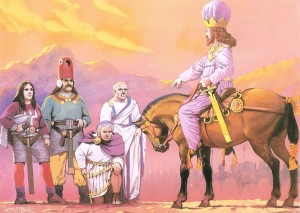
Emperor Valerian and Roman Senator surrender to Shapur I (on horse) escorted by Sassanian cavalry officers (Source: Elite Sassanian Cavalry).
The greatest psychological blow was the capture of Emperor Valerian and his ceremonial chariot as commemorated in the Shapur inscriptions (SKZ -Shapur Kaba Zartusht- Greek lines 19-37) as well as the sites of Naghsh-e-Rustam and Bishapur. Never in the history of Rome had a Roman Emperor been captured alive. According to Ferril:
“Valerian’s defeat and capture number among the most humiliating military losses in Roman history” (Ferrill, 1988, p.38).
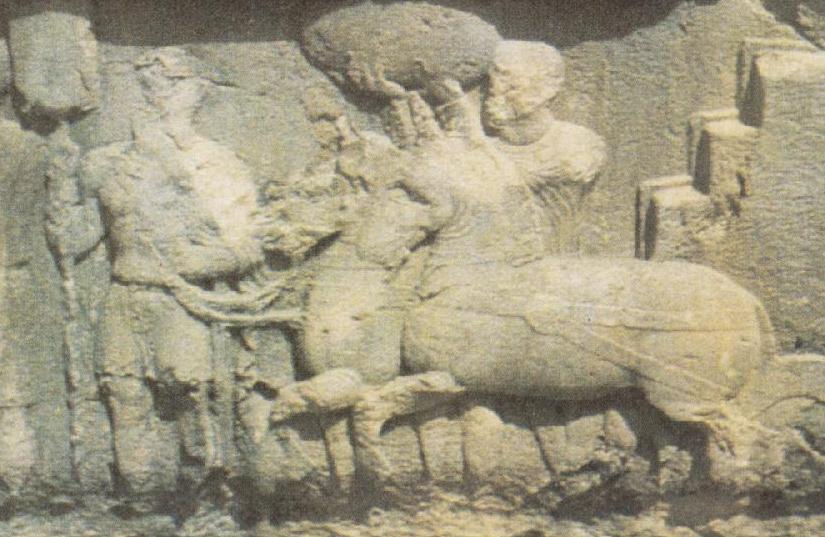
Valerian’s chariot captured by Sassanian troops as depicted at Bishapur.
Roman prisoners included a large number of engineers who were soon put to work building dams and bridges in modern Khuzistan, some of which, like the dam-bridge of Shushtar, have remains which have lasted to this day, a testament to the durability of Roman engineering skills.
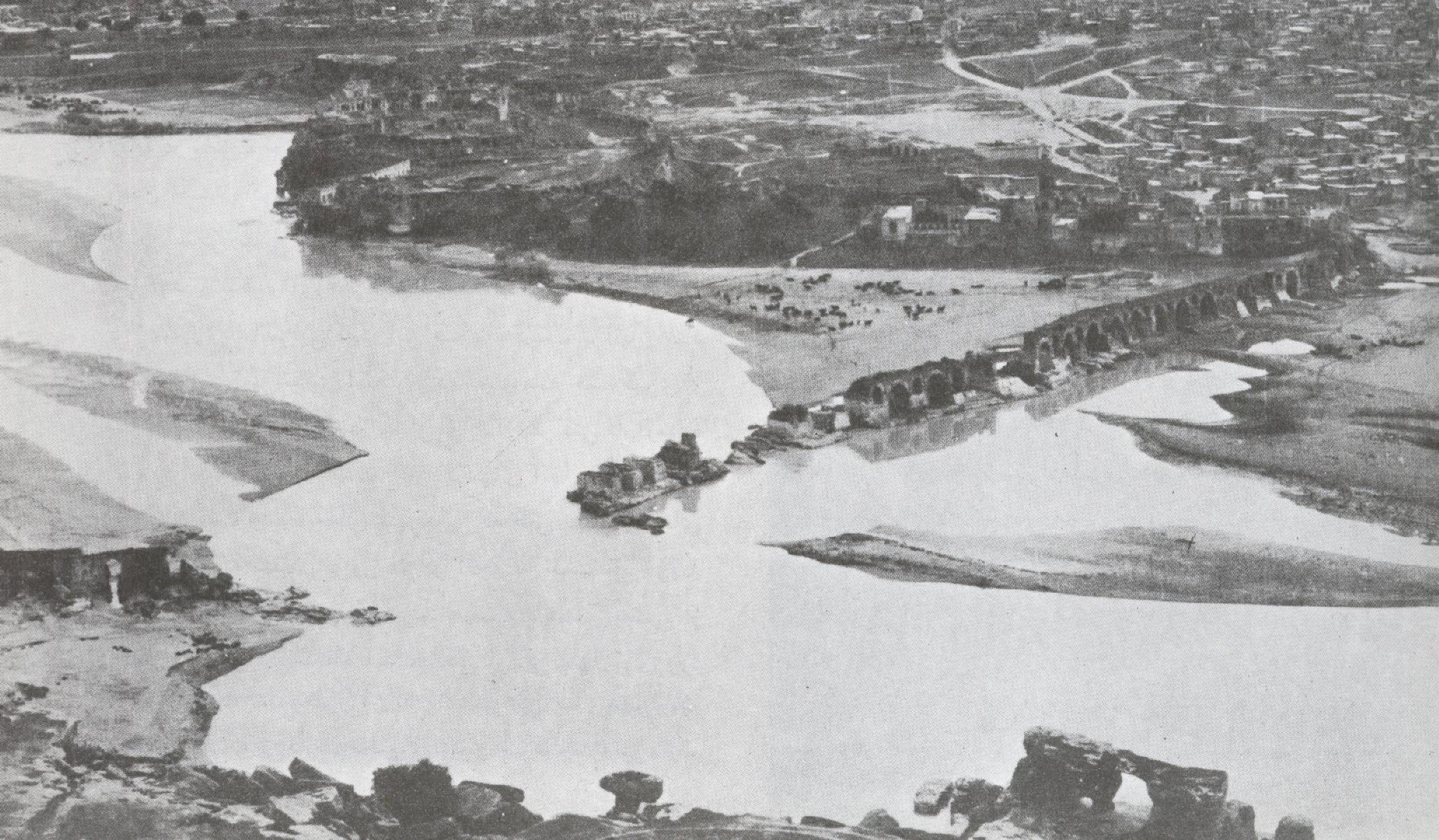
Remains of the bridge at Shushtar build by Roman prisoners of war.
The mosaic works of the Roman craftsmen at Bishapur depicting Sassanian noblewomen and noblemen still stand, with near-intact examples present in the Louvre Museum in Paris.
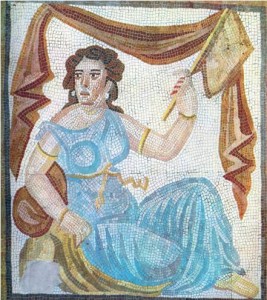
An Iranian noblewoman as depicted by Roman craftsmen captured by Shapur.
Western sources report of Valerian meeting a cruel and tragic end at Persian hands. Roman accounts report him being used as a footstool for Shapur when mounting his horse. After his death Valerian’s body is said to have been stuffed and placed inside a Zoroastrian temple.
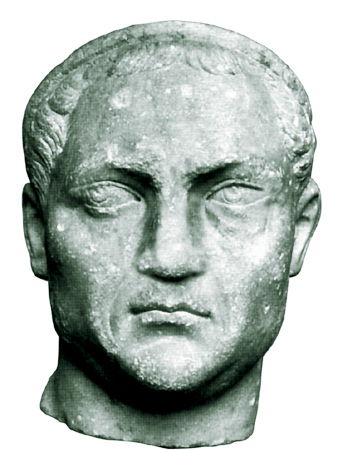
Valerian, the only Roman emperor captured alive in history.
Iranian historical accounts however, dispute Roman and modern western accounts of Valerian’s fate. The Shahnama epic cites Valerian as a man of good character who after his defeat and capture, was treated honorably by Shapur.
The Sassanian knights (the Savaran) soon acquired a fearsome reputation among the Romans. As noted by Libianus’ reference to the Savaran:
“Romans…prefer to suffer any fate rather than look a Persian in the face“
Further Readings
Banchich, T., & Lane, U. (2009). The History of Zonaras: From Alexander Severus to the Death of Theodosius the Great. London & New York: Routledge.
Bekker, I. (1839). Georgius Cedrenus Ioannis Scylitzae Ope. Bonn: Impensis Ed. Webberi.
Dodgeon, M.H. & Lieu, S.M.C. (1991). The Roman Eastern Frontier and the Persian Wars (AD 226-363). London & New York: Routledge.
Eadie, J.W. (1967). The Breviarium of Festus. London: Althone Press.
Farrokh, K. (2005). Elite Sassanian Cavalry. Oxford: Osprey Publishing.
Farrokh, K. (2008). Shadows in the Desert: Ancient Persia at War. Oxford: Osprey Publishing.
Ferrill, A. (1988). The Fall of the Roman Empire: The Military Explanation. London: Thames & Hudson.
Foerster, R. (1909-1927). Libianus. Leipzig: Hinrichs’sche Buchhandlung.
Frye, R.N. (1984). The History of Ancient Iran. Munich, Germany: C.H. Becksche Verlagsbuchhanndlung.
Mommsen, T. (1882). Jordanes: Historia Romana. Berlin: MGH.
Peterson, D. (1992). The Roman Legions recreated in Colour Photographs. London: Windrow & Greene Ltd.
Reitemeier. J.F. (1837). Corpus Scriptorum Historiae Zosimus. Bonn: Impensis Ed. Webberi.
Rolfe, J.C. (1935-1939). Ammianus Marcellinus (Three Voluimes). London: W. Heinemann.
Thompson, G. (1979). Die Oracula Sibyllina. New York: Arno Press.
Zarrin’kub, A. h. (2002). Ruzgaran:tarikh-i Iran az aghz ta saqut saltnat Pahlvi. Tehran: Sukhan.[/fusion_builder_column][/fusion_builder_row][/fusion_builder_container]



